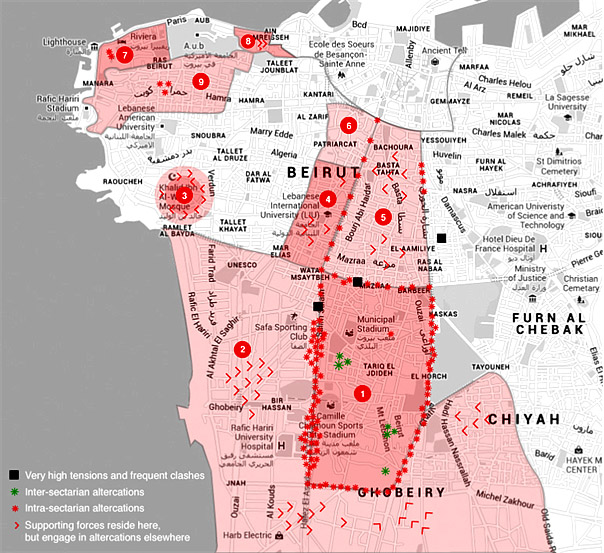 |
|
https://now.mmedia.me A city divided The neighborhoods, streets, and alleyways of Beirut are increasingly being divided along fault lines. Although skirmishes often begin as personal disputes, the political and sectarian tensions entrenched in the city's neighborhoods typically cause them to escalate. A look at Beirut's conflict areas in early 2008 shows that many previous sites of instability remain unchanged. Meanwhile, troubled national and regional issues have intensified friction. Particular areas in Beirut are of concern, and in the event that tensions break out into actual clashes, it will likely be along these dividing lines. Below is a description of Beirut's districts, with each number corresponding to the same number found on the map. Below is a description of Beirut's districts, with each number corresponding to the same number found on the map. 1. The Sunni Square: This Sunni-majority area consists of many Future Movement supporters, as well as other Sunni groups and a small Shiite population. Cross-sectarian skirmishes within this area are uncommon, but clashes do occur between Sunnis who belong to different political factions. These altercations can take place in the neighborhood between the Sports Stadium and the Municipal Stadium, with supporting forces coming from both areas. As of late, gunshots can be heard every two to three days in the Tariq al-Jedideh neighborhood. Border areas: The borders of the Tariq al-Jedideh neighborhood are much more susceptible to cross-sectarian violence, as Saraya al-Muqawama and other forces affiliated with Hezbollah engage with Sunni forces along all four borders of the Sunni-majority neighborhood. Mazraa-Barbour: Since the 1980s, clashes have occurred between the Sunnis of Tariq al-Jedideh and the Shiites across the Corniche al-Mazraa road, particularly around the Gamal Abdel Nasser mosque which falls directly on the fault line. 2. Mixed: The border between this area and Tariq al-Jedideh is marked by the Airport Road, and clashes are frequent along this divide – particularly by the Safa Sporting Club and on the western side of the Sports Stadium. People from the areas north and northwest of the Rafiq Hariri University Hospital often partake in the altercations along the Salim Salam Road. Further south in the Ghobeiry area, which borders the eastern side of Tariq al-Jedideh, supporting forces attack neighborhoods in Tariq al-Jedideh via the Ouzai Road. These attacks frequently feature small rockets launched from this road into Tariq al-Jedideh. Wata Msaytbeh: Specifically, clashes occur in this corner between Tariq al-Jedideh's working-class Sunni population and Hezbollah-affiliated forces across the Airport Road. North of the Hezbollah-controlled neighborhood lies a Druze area, which doesn't normally engage in fighting with the other two groups. 3. Ain al-Tineh: Residence of Nabih Berri Clashes in this area are essentially forbidden, but people from this neighborhood support altercations elsewhere. The Lebanese Army will shut down any possible violence that may occur here. 4. Hay al-Lija: This is a mixed area with a number of sects, although it has a Shiite majority. Again, the area's borders indicate where skirmishes often take place and where high levels of violence may be seen in case of escalating tensions. The Salim Salam road, which borders this area on the east, is one of these fault lines. 5. Basta: Another mixed area lying adjacent to Hay al-Lija, this neighborhood witnesses some internal clashes, but most violence lies along the borders. In March, two Sunni sheikhs from Dar al-Fatwa were attacked and forcefully had their beards shaved in Khandaq al-Ghamiq, which lies in the northern part of this area. Border areas: The roads that border this area – Salim Salam, Ring Road, and Beshara al-Khoury – are often the sites of altercations between Hezbollah-affiliated forces and groups protesting near the Lebanese parliament. Ras al-Nabaa: This neighborhood in particular sees skirmishes between members of a Salafi mosque and the Amal Movement. 6. Patriarcat and Zoqaq al-Blat a. In social composition, this area resembles Hay al-Lija and Basta – yet the region witnesses much more violence. Patriarcat and Zoqaq al-Blat are across from the Presidential Serail. The area's Kurdish population is often harassed by pro-Hezbollah forces, as is the neighborhood's Sunni community. 7. Jal al-Bahr This area is under the control of Walid Jumblatt's Progressive Socialist Party (PSP) and the Beiruti Druze. Interestingly enough, clashes between the PSP and the Syrian Socialist National Party (SSNP) – which controls the Hamra district just southeast of Jal al-Dib – are uncommon. If the political alliance between the PSP and the March 8 Coalition were to fall apart, this area would experience a significant clashes. 8. Ain al-Mrayseh This coastal neighborhood is under the control of the Amal Movement and it is a launching pad for those that engage in fighting elsewhere in Beirut. There aren't many altercations in this area itself, mostly to ensure that the area's businesses continue to be profitable. This is also true in other wealthy areas of the city, where violence is kept to a minimum so that businesses continue to operate unharmed. 9. Hamra A popular destination for youth any night of the week, this neighborhood is under the control of the Syrian Socialist Nationalist Party (SSNP), a member of the March 8 coalition. The pubs and restaurants here often pay "protection fees" to the SSNP so that party members refrain from attacking their establishments. The SSNP leadership can make their own decisions as whether to provoke altercations in the Hamra neighborhood, but it also executes directives from Hezbollah. If tensions escalate, SSNP forces from the Hamra area could be expected to take over Hariri Square, which is located just east of the Lebanese American University. A small area at the beginning of Hamra Street, it is increasingly inhabited by members of the Syrian opposition – and the SSNP is seeking to regain control of this area.
|
|
|